The marinade, essential to any great bulgogi dish, is a harmonious fusion of ingredients such as soy sauce, sugar, garlic, and sesame oil, with hints of ginger and fruit for natural sweetness, creating a beef bulgogi recipe that is both authentic and approachable.
In this recipe for bulgogi, every step from slicing the beef paper-thin to allowing ample marinating time is designed to maximize flavor and tenderness, resulting in a dish that epitomizes the best of bulgogi Korean meat.
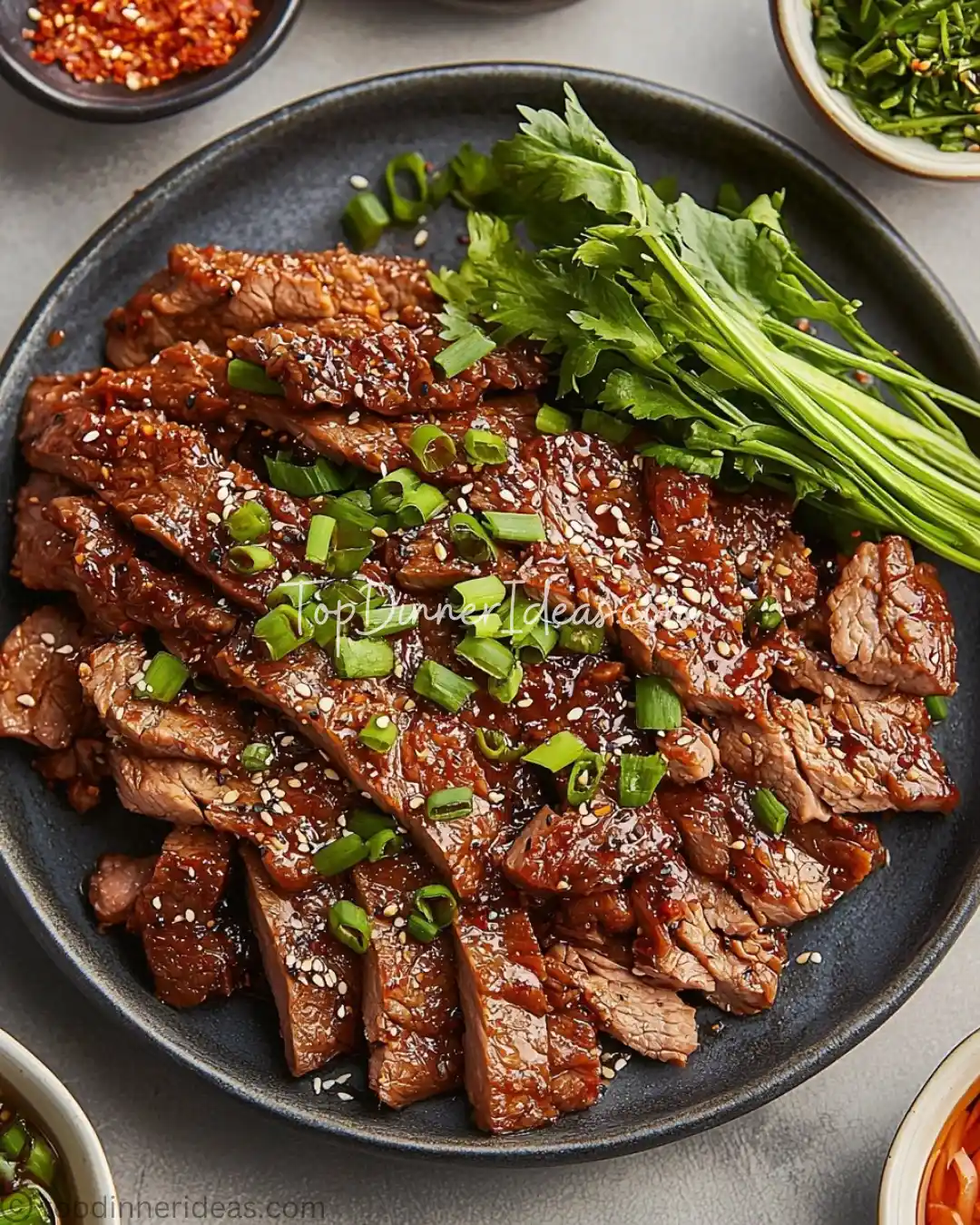
For me, bulgogi is the perfect embodiment of Korean barbecue simple in ingredients yet sophisticated in flavor, providing a balanced, delicious meal that pairs beautifully with steamed rice and a variety of banchan (Korean side dishes).
Ultimately, whether you’re making your own bulgogi sauce from scratch or marinating the beef for hours to achieve meltingly tender results, this bulgogi recipe promises a culinary experience that is both authentically Korean and utterly satisfying.
Equipments for
The right equipment is key to preparing perfect bulgogi; from slicing the beef paper-thin to searing it quickly on a hot surface, every tool contributes to creating a dish with impeccable texture and intense flavor.
- Sharp Knife and Cutting Board: Essential for slicing the beef thinly and evenly.
- Large Mixing Bowl or Ziplock Bag: For marinating the beef thoroughly.
- Grill, Grill Pan, or Large Skillet: To quickly sear the beef, ensuring a caramelized exterior.
- Measuring Cups and Spoons: For accurately adding marinade ingredients.
- Tongs: To flip and transfer the beef during cooking.
- Optional: A food processor for blending marinade ingredients smoothly.
By assembling these tools, you’ll be perfectly equipped to create a bulgogi dish that boasts tender, flavorful beef with an inviting char and glossy marinade.
Ingredients for
The ingredients for this bulgogi recipe are carefully selected to create a marinade that infuses the beef with layers of sweet, savory, and smoky flavors, ensuring every bite of this beef bulgogi is bursting with Korean-inspired taste.
For the Beef:
1 1/2 lbs beef sirloin or ribeye, thinly sliced against the grain – quality beef is essential for tenderness
Salt and freshly ground black pepper – to season lightly before marinating
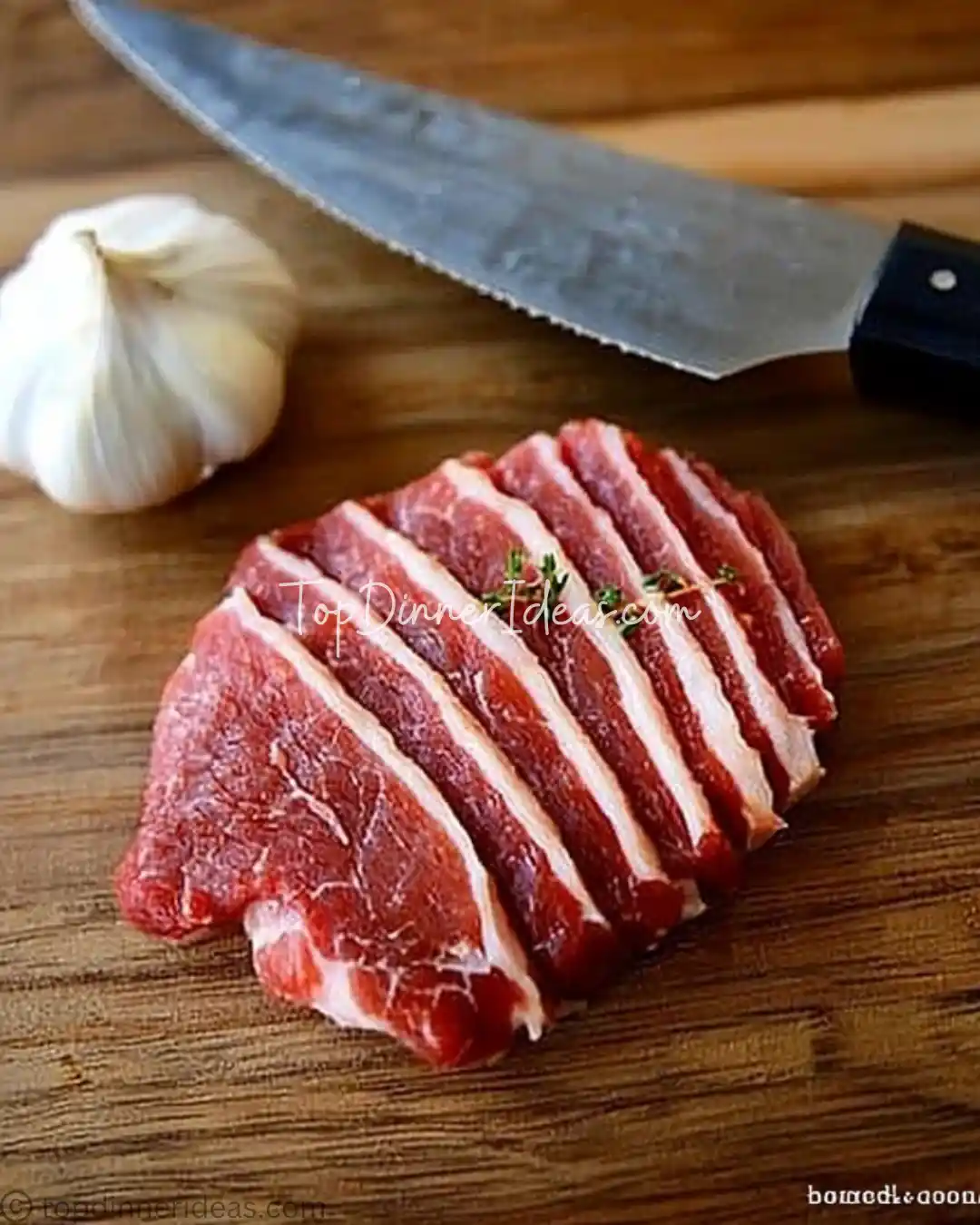
For the Marinade:
1/2 cup soy sauce – the savory base
1/4 cup brown sugar – provides sweetness and caramelization
2 tablespoons sesame oil – for nutty, rich flavor
1/4 cup rice wine or mirin – enhances the marinade’s depth
4 garlic cloves, minced
1 tablespoon ginger, grated
2 green onions, thinly sliced
1 tablespoon gochujang (optional) – for a hint of heat and spice
1 Asian pear, grated (or 1/2 cup apple, grated) – natural tenderizer and sweetness
1 tablespoon toasted sesame seeds – for garnish and a nutty crunch
For Garnish (Optional):
Additional sliced green onions and sesame seeds
By combining these carefully measured ingredients, you build a robust bulgogi sauce recipe that transforms the beef into a succulent, flavor-packed centerpiece for your meal.
Instructions to
Follow these step-by-step instructions to create an authentic and mouthwatering bulgogi dish that showcases the perfect balance of marinated, seared beef and vibrant Korean flavors.
Prepare the Beef:
– Slice the Beef: Place the beef in the freezer for about 30 minutes to firm it up slightly, which makes it easier to slice. Then, using a sharp knife, slice the beef thinly against the grain.
– Season Lightly: Lightly season the sliced beef with salt and pepper.
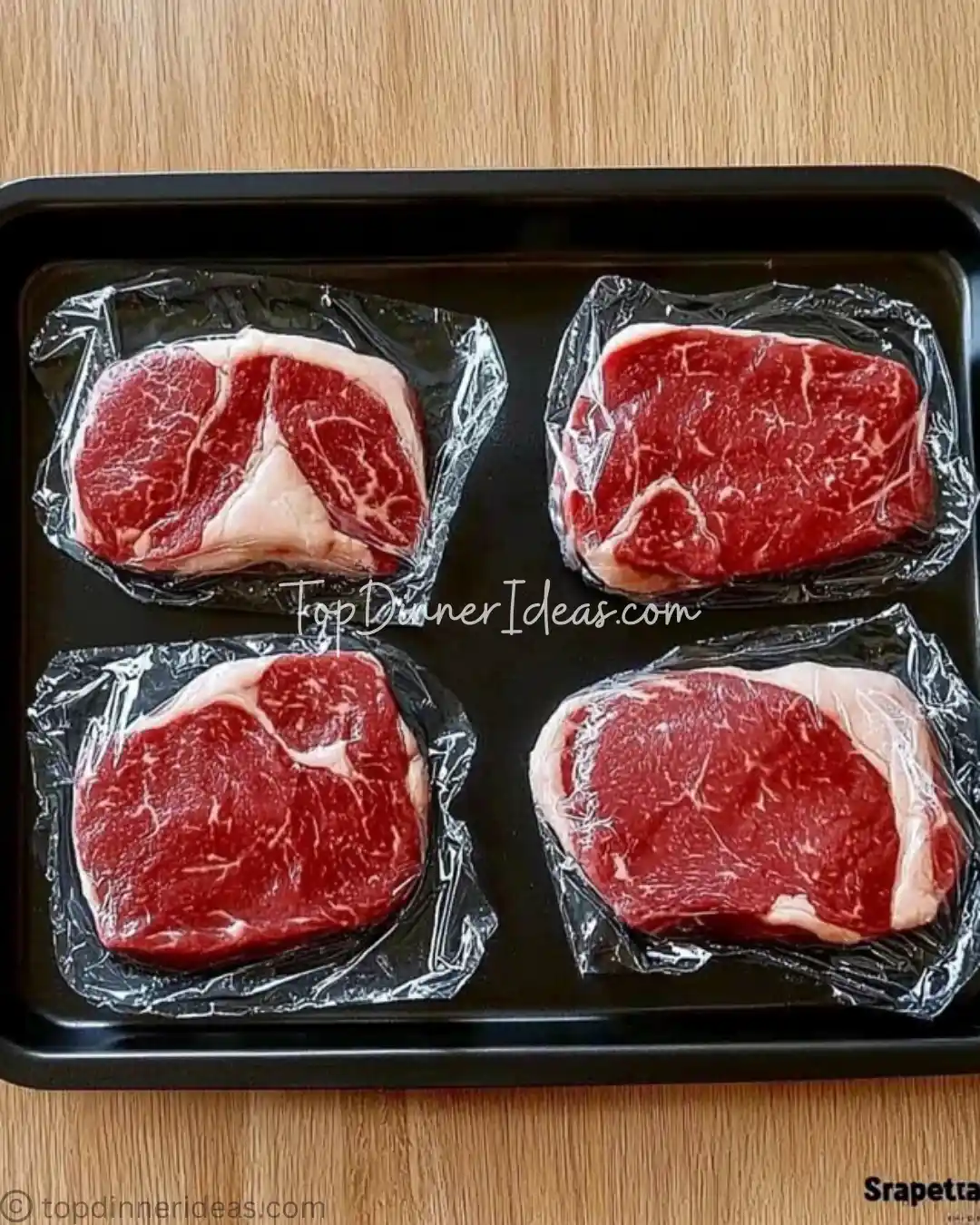
Make the Marinade:
– In a large mixing bowl (or a Ziplock bag), combine soy sauce, brown sugar, sesame oil, rice wine (or mirin), minced garlic, grated ginger, green onions, grated Asian pear (or apple), and gochujang if using.
– Whisk the mixture until the sugar is mostly dissolved.
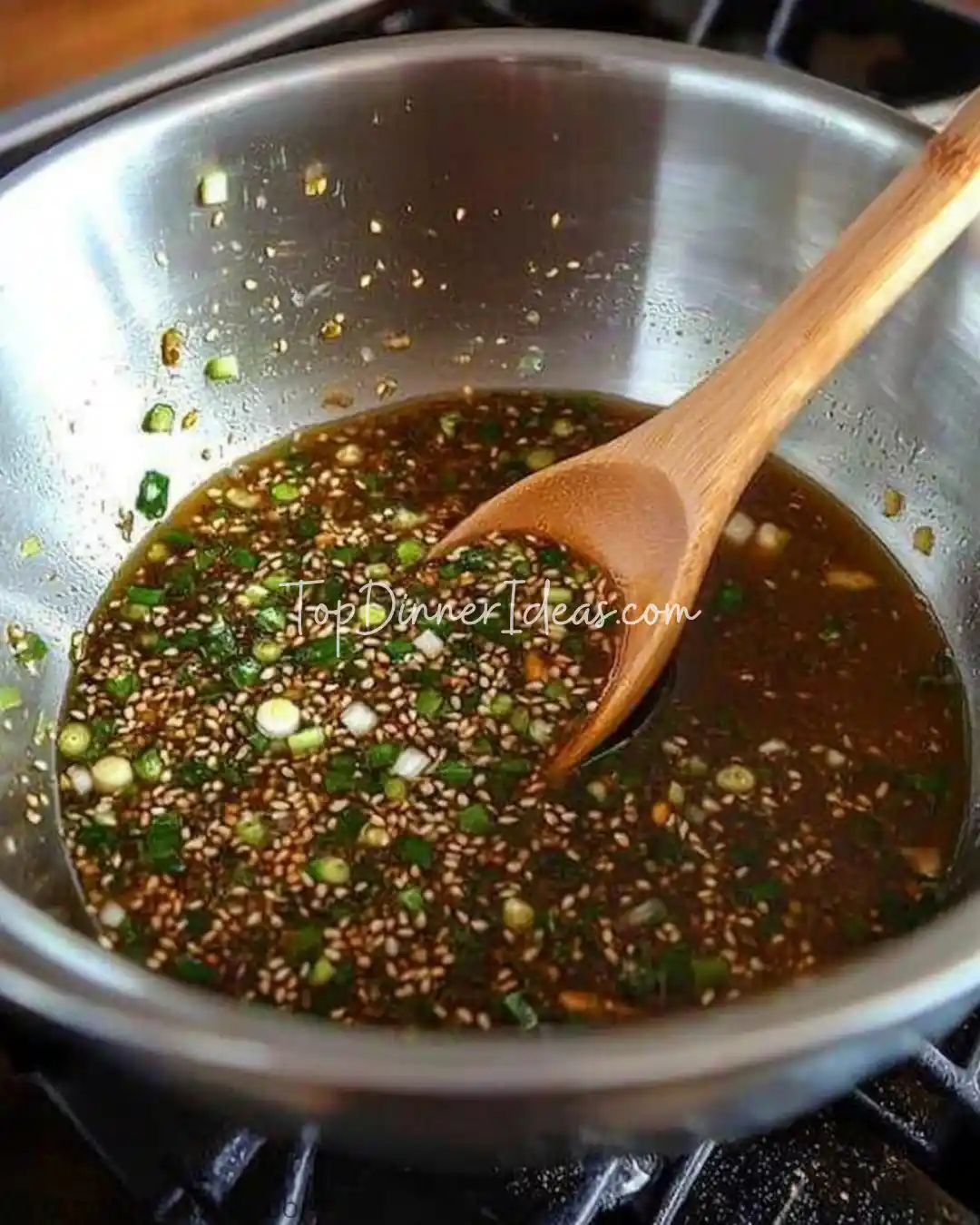
Marinate the Beef:
– Add the sliced beef to the marinade, ensuring every piece is well coated.
– Cover the bowl or seal the bag and refrigerate for at least 4 hours, preferably overnight, to allow the flavors to deeply penetrate the meat.
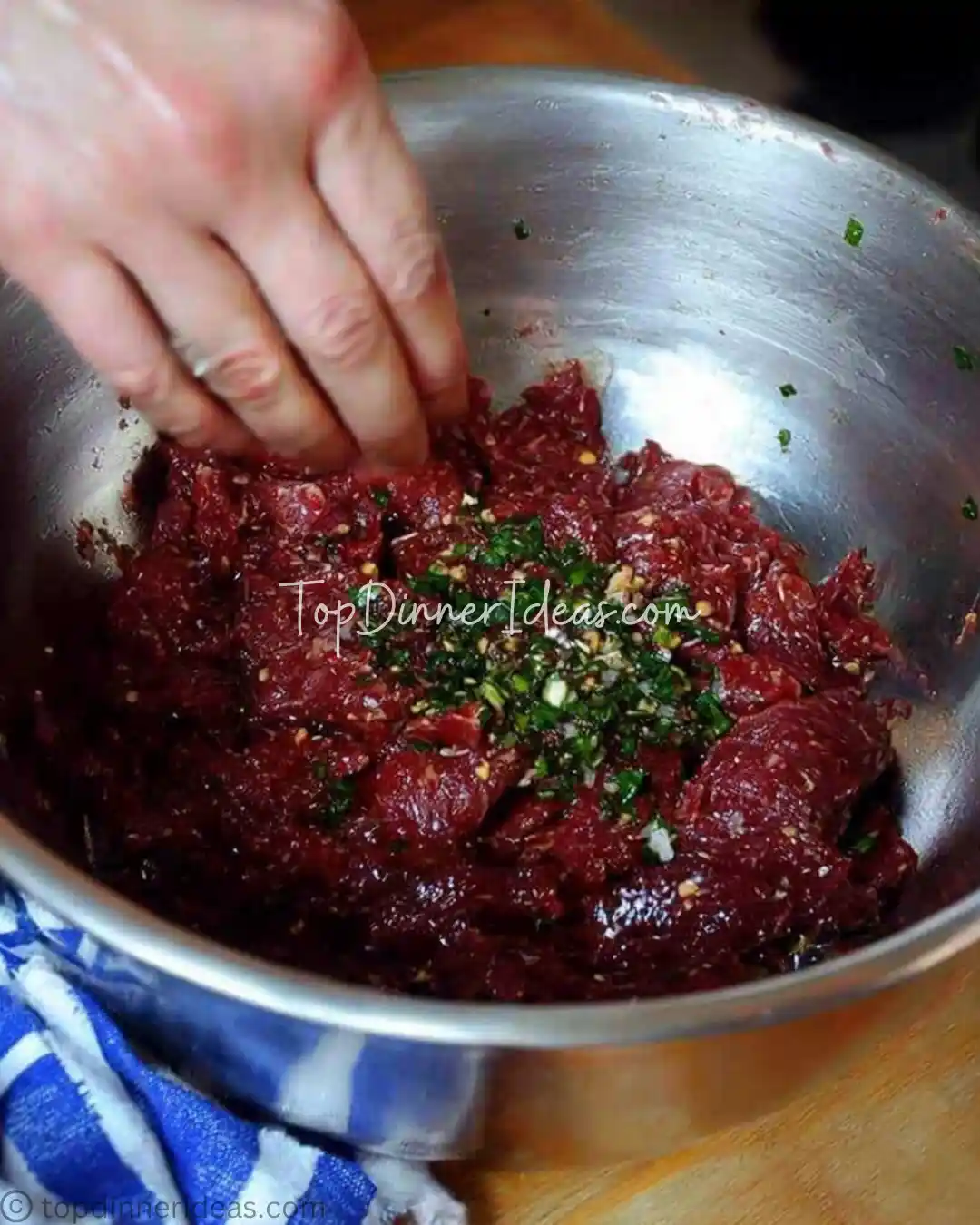
Preheat Your Cooking Surface:
– Grilling Method: Preheat your grill or grill pan to high heat.
– Stovetop Method: Preheat a large skillet over high heat.
Cook the Bulgogi:
– Remove the beef from the marinade, letting the excess drip off (reserve the marinade for later, if desired).
– For Grilling: Place the beef slices in a single layer on the preheated grill or cedar plank if you want extra smoky flavor. Grill for 2–3 minutes per side until nicely charred but not overcooked.
– For Stovetop: Add the beef slices in batches to the hot skillet. Sear for about 2–3 minutes per side until caramelized and tender.
– (Optional) In a separate pan, simmer the reserved marinade for 2–3 minutes to serve as a sauce.
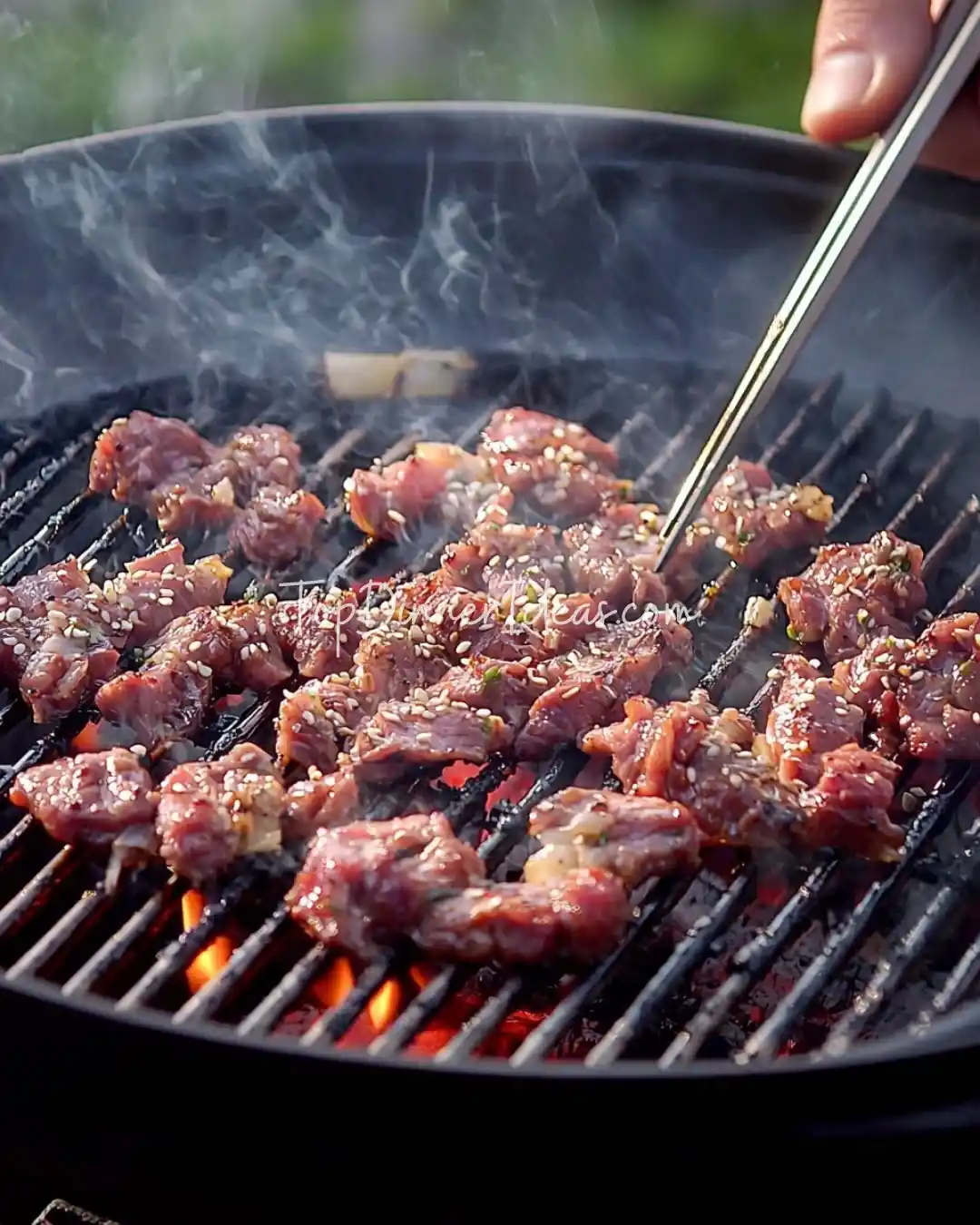
Finish and Serve:
– Transfer the cooked beef bulgogi to a serving platter.
– Garnish with extra sliced green onions, toasted sesame seeds, and additional sesame oil if desired.
– Serve immediately with steamed rice, lettuce wraps, or your favorite Korean side dishes.
By following these steps, you’ll create a beef bulgogi recipe that is bursting with authentic Korean flavors, featuring tender, marinated meat with an irresistible balance of sweet, savory, and smoky notes.
Allergen Information for
It’s important to review allergen information for this bulgogi recipe to ensure it meets the dietary needs of everyone enjoying the meal.
- Soy: Contains soy sauce; substitute with a gluten-free tamari if needed.
- Fruits: Contains Asian pear (or apple); omit if allergic.
- Sesame: Contains sesame oil and seeds; use alternatives if necessary.
- Optional Heat: Gochujang contains wheat and chili; check labels for gluten-free or substitute with a homemade chili paste.
By carefully considering these allergen details, you can modify the recipe to accommodate various dietary requirements without losing the bold flavors of an authentic bulgogi dish.
Substitutions for
This bulgogi recipe is versatile and can be adapted through various substitutions to suit your taste, dietary needs, or ingredient availability.
- Protein: Substitute beef with pork, chicken, or tofu for different protein variations.
- Fruit Component: If you do not have an Asian pear, use a small apple or omit it; it acts as a tenderizer and subtle sweetener.
- Soy Sauce: Use tamari for a gluten-free option.
- Spice Level: Adjust or omit gochujang to suit your desired heat level.
- Cooking Method: If you don’t have a grill, pan-searing on the stovetop achieves excellent results.
By embracing these substitutions, you can easily tailor your bulgogi to create a dish that perfectly aligns with your culinary preferences and dietary restrictions, all while delivering the authentic taste of Korean meat.
Variations of
Experiment with different variations of this bulgogi recipe to add your own twist or try out new flavors while still preserving the essence of traditional Korean beef bulgogi.
- Spicy Bulgogi: Increase the amount of gochujang or add red pepper flakes for extra heat.
- Bulgogi Lettuce Wraps: Serve the cooked bulgogi in crisp lettuce leaves with a drizzle of the simmered marinade and chopped scallions.
- Bulgogi Rice Bowl: Layer the bulgogi over steamed rice and top with pickled vegetables for a complete meal.
- Vegetarian Bulgogi: Replace beef with marinated tofu or portobello mushrooms and follow the same marinade process.
- Bulgogi Noodle Stir-fry: Toss the cooked bulgogi with stir-fried vegetables and noodles for a Korean-inspired pasta dish.
- Fusion Twist: Use the bulgogi as a topping for pizza or tacos, combining traditional Korean flavors with international favorites.
These creative variations allow you to reinvent the classic bulgogi recipe to suit different occasions and personal tastes, ensuring that every adaptation remains true to the dish’s bold and savory spirit.
Notes on
The following practical notes provide useful tips to enhance your bulgogi experience, ensuring every step is streamlined and every bite is packed with flavor.
- Partially freeze the beef for about 30 minutes before slicing; this makes it easier to achieve paper-thin slices.
- Marinating overnight is ideal for maximum flavor penetration.
- Use a sharp knife for slicing to ensure uniformity and better texture.
- Avoid overcrowding the pan during cooking to achieve a proper sear and caramelization.
- Reserve any leftover marinade and bring it to a boil to use as an extra sauce ensure to cook it thoroughly for food safety.
- Garnish just before serving to maintain fresh herb flavors.
By keeping these notes in mind, you’ll fine-tune your technique and elevate your bulgogi to a level of perfection that is as authentic as it is memorable.
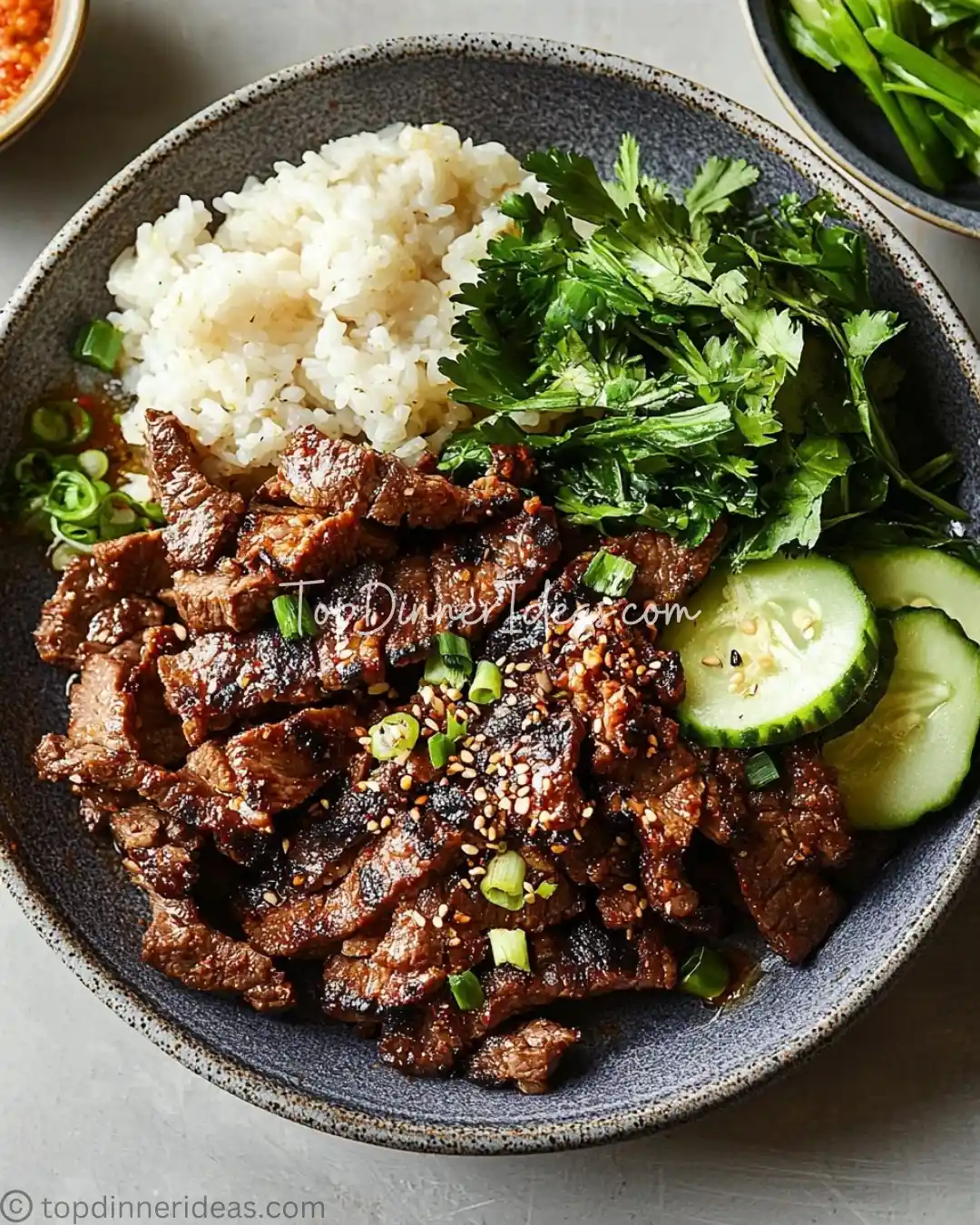
Health Benefits of
In addition to its rich, complex flavor, bulgogi offers several nutritional benefits that make it a valuable addition to a balanced diet.
- Beef: Provides high-quality protein, iron, and essential B vitamins necessary for energy and muscle repair.
- Asian Pear/Apple: Adds natural sweetness and contains enzymes that aid in digestion while tenderizing the meat.
- Garlic and Ginger: Known for their anti-inflammatory and immune-boosting properties.
- Sesame Oil: Offers healthy fats and antioxidants.
- Herbs and Spices: Contribute minimal calories while enhancing overall flavor and providing various health-promoting antioxidants.
By integrating these nutritious ingredients, your bulgogi not only satisfies the palate but also supports a balanced, protein-rich diet with a touch of natural sweetness and spice.
Nutrition Information
Here’s an approximate nutritional breakdown per serving to give you a clear idea of how this bulgogi dish fits into a well-balanced meal plan.
- Calories: 350–400 kcal
- Protein: 30–35 g
- Carbohydrates: 15–20 g (including a small contribution from fruit and vegetables)
- Fats: 18–22 g
- Vitamins & Minerals: Rich in B vitamins, iron, and antioxidants from garlic and ginger
With this nutritional overview, you can enjoy each serving of your bulgogi with the assurance that it delivers a balanced mix of macronutrients and essential vitamins while delighting your taste buds.
Nutritional values can vary based on specific ingredient brands and measurements used. For more precise information, refer to the labels of your chosen ingredients.
Cooking Tips for
Follow these helpful cooking tips to ensure your bulgogi is both perfectly marinated and expertly seared, delivering the ideal blend of flavors and textures.
- Partial Freezing: Chill the beef briefly to help slice it very thinly and uniformly.
- Marination: Marinate the beef for at least 4 hours, preferably overnight, to maximize flavor penetration.
- High Heat Searing: Cook in batches over high heat to achieve a nice caramelization; avoid steaming the meat.
- Do Not Overcrowd: Give the beef room in the pan so it sears properly rather than boiling in its juices.
- Monitor Sauce: If using the reserved marinade as a sauce, bring it to a boil for 2–3 minutes for safety and flavor concentration.
- Timing: Since the beef cooks quickly, keep a close eye on it 2–3 minutes per side is usually ideal for thin slices.
By following these tips, you’ll consistently produce a bulgogi dish that is beautifully caramelized, tender, and bursting with authentic Korean flavors.
Storage Advice for
Proper storage of any leftovers from your bulgogi is essential to preserve its vibrant flavors and tender texture for later enjoyment.
- Refrigeration: Store any extra bulgogi in an airtight container in the refrigerator for up to 2 days.
- Reheating: Gently reheat in a skillet over low heat, or microwave with short bursts to avoid overcooking.
- Freezing: While best enjoyed fresh, you can freeze bulgogi in a freezer-safe container for up to 1 month; thaw overnight in the refrigerator before reheating.
- Labeling: Mark the container with the date to ensure freshness is maintained.
By following these storage practices, you can extend the delicious experience of your bulgogi while preserving its original taste and texture.
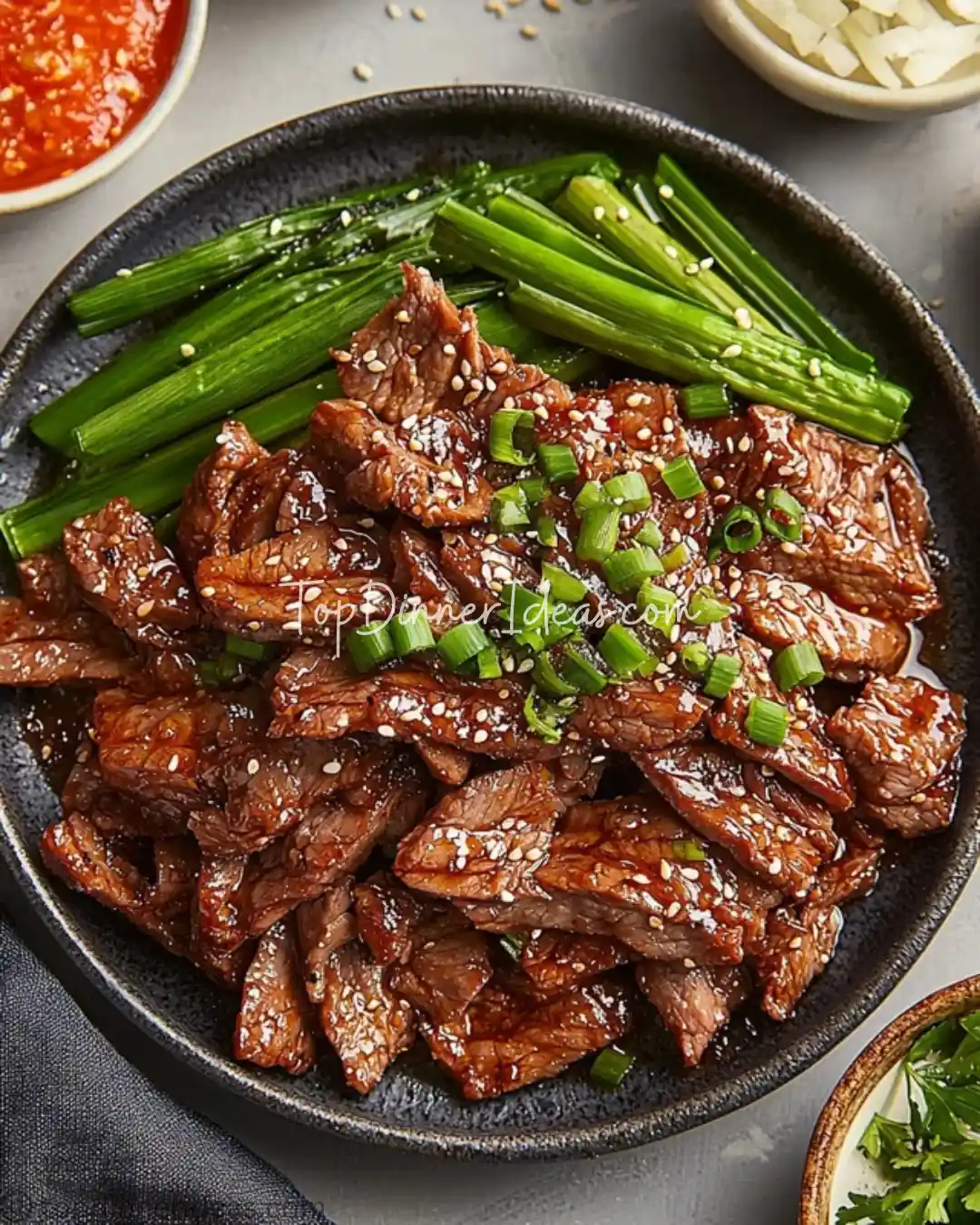
Serving Suggestions for
Enhance your dining experience with creative serving suggestions that complement your bulgogi and turn it into a complete, satisfying meal.
- Rice: Serve over steamed white or brown rice to soak up the savory sauce.
- Lettuce Wraps: For a lighter option, spoon bulgogi into crisp lettuce leaves with a drizzle of sauce.
- Noodles: Toss with stir-fried noodles and vegetables for a Korean-inspired noodle dish.
- Banchan: Pair with traditional Korean side dishes such as kimchi, pickled radish, and steamed vegetables.
- Salad: Serve alongside a simple cucumber salad with a sesame dressing for a refreshing contrast.
- Wraps: Create wraps using tortillas or rice paper for a fusion-style meal.
With these serving suggestions, your bulgogi transforms into a versatile meal option that pairs perfectly with a variety of sides making it an ideal centerpiece for any dining occasion.
Troubleshooting
If you encounter any issues while making bulgogi, these troubleshooting tips provide practical solutions to ensure your dish always turns out perfectly.
- Issue: Beef isn’t tender enough.
Solution: Ensure the meat is thinly sliced and marinate it for a longer period (overnight is best); consider using a tender cut like ribeye. - Issue: Marinade flavor is too mild.
Solution: Adjust the seasonings by adding a bit more soy sauce, sugar, or garlic; also, ensure sufficient marination time. - Issue: Beef is overcooked and dry.
Solution: Sear the beef quickly over high heat and avoid overcrowding the pan. - Issue: Sauce is too thin.
Solution: Let the reserved marinade simmer for a few minutes to reduce and concentrate the flavors before serving. - Issue: Flavor imbalance.
Solution: Taste throughout the cooking process and adjust seasonings gradually to suit your palate.
By applying these troubleshooting tips, you can navigate any challenges during preparation and ensure that your bulgogi is always tender, flavorful, and perfectly balanced.
FAQ About
Use beef sirloin, ribeye, or flank steak; the meat should be thinly sliced for optimal tenderness.
Aim for paper-thin slices; partially freeze the beef for about 30 minutes before slicing.
Yes, marinate the beef overnight; cook and store leftovers in the refrigerator for up to 2 days.
Asian pear adds natural sweetness and acts as a tenderizer; if unavailable, a small apple can be used as an alternative.
Gochujang adds a subtle heat and depth of flavor; it is optional and can be adjusted based on your spice preference.
Absolutely, grilling gives the meat a delightful char and smoky taste.
Bring any reserved marinade to a boil for at least 2–3 minutes before serving it as a sauce.
Serve with steamed rice, lettuce wraps, or stir-fried vegetables for a complete meal.
Yes, use tamari or another gluten-free soy sauce.
Replace beef with marinated tofu or portobello mushrooms and follow the same marinating and cooking process.
By addressing these frequently asked questions, you can confidently prepare your bulgogi and tailor the dish to your specific tastes, ensuring a delightful culinary experience every time.
Footnotes for
In conclusion, this bulgogi recipe offers a vibrant exploration of Korean flavors, transforming thinly sliced beef into a tender, savory, and slightly sweet dish that is both authentic and versatile.
Whether you choose to grill the meat to achieve that perfect char or cook it on the stovetop for a quick sear, every step of the process is designed to highlight the intricate balance of the bulgogi sauce rich with soy, garlic, ginger, and a touch of fruit sweetness.
Enjoy experimenting with variations and substitutions to make the recipe uniquely yours, and share this classic Korean beef dish with family and friends for an unforgettable meal.
For more inventive recipes and culinary inspiration, Navigate to our Main Dishes section, or visit Trustedrecipe, www.feastingathome.com or explore additional ideas on Food Network. Thank you for choosing this recipe may every spoonful bring comfort, joy, and a taste of home to your table!



